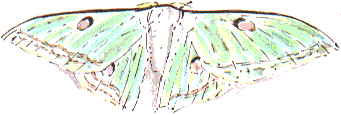 |
Moon MothTuesday, 17th July 2001, West Yorkshire |
![]()
![]()
![]()
![]()
![]()
![]() This Month
Rocks
History
Workshop
Links
Home Page
This Month
Rocks
History
Workshop
Links
Home Page
![]()
 THIS MOTH, found in a garden in Ossett, West Yorkshire, has a seven inch (17 cm) wingspan. It's a Moon Moth, probably the Indian Moon Moth, Actias selene, which ranges from India to Japan. The adults have no mouthparts and live no more than a week or two.
THIS MOTH, found in a garden in Ossett, West Yorkshire, has a seven inch (17 cm) wingspan. It's a Moon Moth, probably the Indian Moon Moth, Actias selene, which ranges from India to Japan. The adults have no mouthparts and live no more than a week or two.They are often reared by enthusiasts, which no doubts explains its presence here.
 This is a female; she has smaller antennae than the male, which is more brightly coloured and which has swept back, falcate, forewings. Both sexes have long swallowtail streamers, but these have probably been pecked by birds or lost in general wear and tear. The female lays 250-300 eggs. The caterpillars accept a wide range of foodplants including Rhodendron, Hawthorn, Oak, Lilac and cherry.
This is a female; she has smaller antennae than the male, which is more brightly coloured and which has swept back, falcate, forewings. Both sexes have long swallowtail streamers, but these have probably been pecked by birds or lost in general wear and tear. The female lays 250-300 eggs. The caterpillars accept a wide range of foodplants including Rhodendron, Hawthorn, Oak, Lilac and cherry.Related Link
Saturniidae of the Western Palaearctic by A.R. Pittaway.![]()
Richard Bell,
wildlife illustrator
E-mail; 'richard@willowisland.co.uk'
![]() Next page
Previous page
This day last year
This month
Nature Diary
Home Page
Next page
Previous page
This day last year
This month
Nature Diary
Home Page
![]()